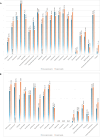Prevailing Antibiotic Resistance Patterns in Hospitalized Patients with Urinary Tract Infections in a Vietnamese Teaching Hospital (2014 - 2021)
- PMID: 39911566
- PMCID: PMC11794383
- DOI: 10.2147/IDR.S499804
Prevailing Antibiotic Resistance Patterns in Hospitalized Patients with Urinary Tract Infections in a Vietnamese Teaching Hospital (2014 - 2021)
Abstract
Purpose: In a Vietnamese teaching hospital, this study examined the prevalence and patterns of antimicrobial resistance (AMR) of common bacteria isolated from hospitalized patients with urinary tract infections (UTIs) between 2014 and 2021.
Methods: From 4060 urine samples collected, common pathogens were isolated using quantitative culture on brilliance UTI Clarity agar and blood agar. Bacterial identification, antimicrobial susceptibility testing, and multidrug resistance (MDR) classification followed standardized techniques. Bacteria with a frequency of less than 2% were excluded. Statistical analysis was performed using R software, with the chi-square test applied and significance set at p < 0.05.
Results: Of 4060 urine samples collected, 892 (22.0%) had positive results for common infections. Gram-negative bacteria predominated (591/892; 66.3%), with Escherichia coli being the most prevalent (336/892; 37.7%). Enterococcus spp. (152/892; 17.0%) was the leading Gram-positive pathogen. Some antibiotics had significant resistance rates, especially in Gram-negative bacteria, with ampicillin having the greatest resistance rate (92.8%). Carbapenems and nitrofurantoin remained generally effective. Among Gram-positive bacteria, high resistance was seen for macrolides ranging from 85.5% (azithromycin) to 89.8% (erythromycin), and for tetracyclines, ranging from 0% (teicoplanin) to 85.2% (tetracycline). There was no resistance to tigecycline and teicoplanin, indicating their potential efficacy against multidrug resistance (MDR) bacteria causing UTIs. MDR rates were higher in Gram-negative bacteria (64.8% versus 43.5%), with Klebsiella pneumoniae having the highest rate (78.7%).
Conclusion: This study underscores the urgent need for ongoing surveillance of AMR patterns in Vietnam and emphasizes the significance of efficient infection prevention methods, prudent use of antibiotics, and targeted interventions to combat antimicrobial resistance.
Keywords: MDR; UTIs; Vietnam; antimicrobial resistance; multidrug resistance; urinary tract infections.
© 2025 Le et al.
Conflict of interest statement
The authors report no conflicts of interest in this work.
Figures



References
-
- Urine Cultures. Clinical Microbiology Procedures Handbook. 2016:3.12.1–3.12.33.
-
- Mlugu EM, Mohamedi JA, Sangeda RZ, Mwambete KD. Prevalence of urinary tract infection and antimicrobial resistance patterns of uropathogens with biofilm forming capacity among outpatients in morogoro, Tanzania: a cross-sectional study. BMC Infect Dis. 2023;23(1):660. doi:10.1186/s12879-023-08641-x - DOI - PMC - PubMed
LinkOut - more resources
Full Text Sources
Miscellaneous

